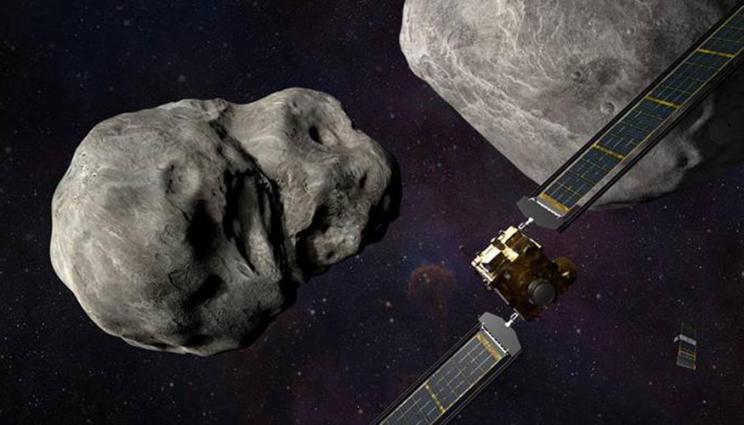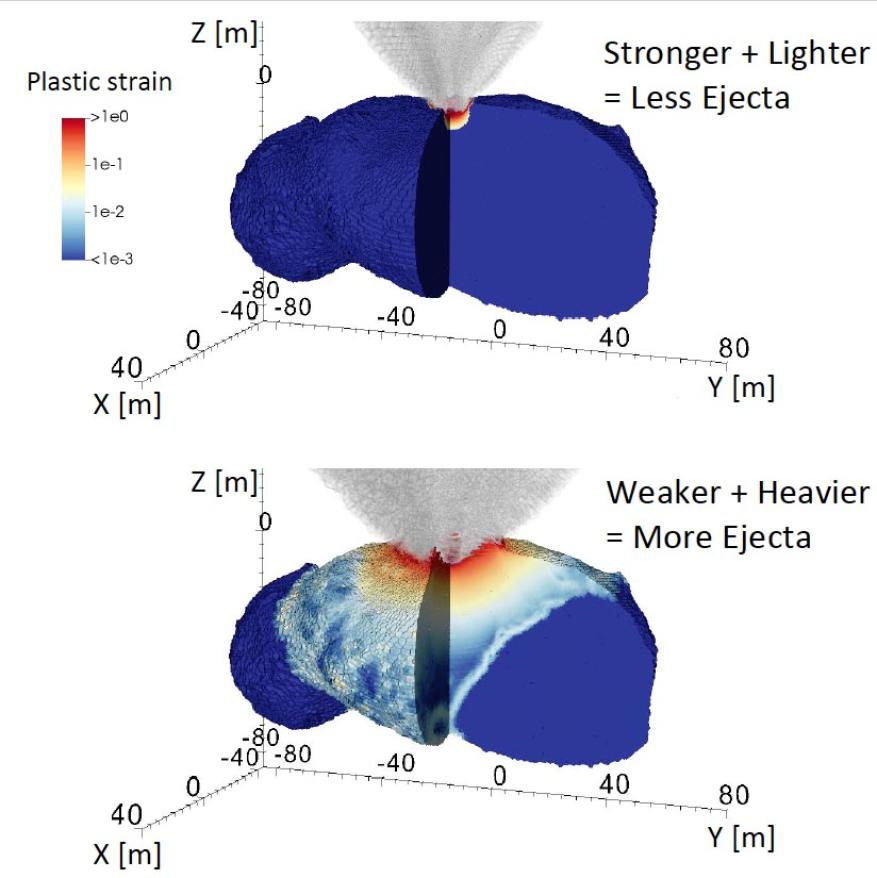
Illustration of NASA's DART spacecraft and the Italian Space Agency's LICIACube prior to impact at the Didymos binary system. Credits: NASA/Johns Hopkins APL/Steve Gribben.
Today at 4:14 p.m. (PDT), NASA's Double Asteroid Redirection Test (DART) Mission will execute the first-ever asteroid-deflection test by crashing into asteroid Dimorphos.
Traveling at ~6 km/s with a mass of ~600 kg, the DART spacecraft will transfer enough momentum for the imparted change in velocity to be detectable from Earth-based telescopes. However, there is significant uncertainty in how the asteroid may respond, due to essentially no prior information about its shape, density, strength and structure. All of these properties affect the impact crater ejecta produced in the experiment, and the ejecta can provide a significant multiplier to the initial spacecraft momentum.
A new paper in Planetary Science Journal titled "Predicting asteroid material properties from a DART-like kinetic impact," led by LLNL's Kathryn Kumamoto, walks through a detailed "dress rehearsal" for interpretation of the real DART experiment's data.
Impact modelers will be faced with the difficult task of using a delta-v and a few final images from DART's DRACO camera to construct simulations that can be used to infer something about Dimorphos' material properties.
To prepare for this, a Johns Hopkins Applied Physics Laboratory (JHUAPL) and Los Alamos National Laboratory "Red Team" created a "Truth Simulation" using a detailed asteroid shape model, providing the calculated delta-v to impact modeling teams around the world. Kumamoto led the LLNL "Blue Team," and used the opportunity to run more than 300 3-D simulations in Spheral, LLNL's meshless Adaptive Smoothed Particle Hydrodynamics (ASPH) code, sampling over seven different material parameters.
In order to efficiently cover the search space, machine learning was used to select parameter combinations. This helped focus the search over material properties that were likely to produce a result within the error bars of the targeted delta-v. Ultimately, the Blue Team solutions did include combinations of material properties that were very close to the Truth Simulations. However, there were many possible solutions consistent with the final delta-v, some of which were quite different from the Red Team's Truth Simulations. One of the largest levers was porosity, because it directly affects the asteroid's total mass. For example, a lower-porosity asteroid (more massive) with low strength (more ejecta, more push) can end up receiving the same delta-v as a higher-porosity (less massive) and higher strength (less ejecta, less push) asteroid. Solutions within the error bars of the measured delta-v included strengths ranging from a few kPa (sand-like) to more than 100 MPa (competent rock) and porosity from 11% to 60%.
"It is no surprise that this problem is degenerate, since we're trying to match a set of seven material parameter inputs to the single output of velocity," says Kumamoto. "But this study is an important step for understanding, and explicitly describing, what we can and cannot constrain or predict about impacting an uncharacterized asteroid."
Fortunately, the European Space Agency's Hera Mission is slated to perform detailed reconnaissance of asteroid Dimorphos and its larger companion, Didymos, starting in early 2027. This new inject of information, which should include a more tightly constrained mass for Dimorphos and the DART impact crater size, is anticipated to narrow the range of possible material properties for Dimorphos. However, even if the DART experiment's target asteroid can eventually be well-constrained, Dimorphos' properties will not necessarily be representative of future asteroid threats.
"DART is a very important first step for planetary defense technology demonstration, but this study highlights how many open questions will remain after the experiment," said Megan Bruck Syal, LLNL's planetary defense project lead.
LLNL's Mike Owen, Cody Raskin, Jason Pearl and Megan Bruck Syal were co-authors on the study.
Live coverage of the DART impact begins at 3 p.m. (PDT) on NASA's website.







